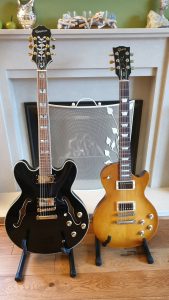This post is part of our Research Initiation Scheme for 2021-2022.
On the 28th of January, Dr Piotr Blumczynski (Translation and Interpreting, QUB) delved into the fascinating world of translation and highlighted the rich and sacred history the word bears. Beyond its textual realms, translation also describes the transfer of a dead body or relic to a new place of veneration, therefore bringing into conversation what translation does and how it is experienced. It is this experiential nature of translation that led Dr Blumczynski to introduce the term translationality. Drawing from three intriguing artefacts, Dr Blumczynski showed how holy relics, palaeolithic caves and the electric guitar of a famed artist can all evoke a translational experience. That is, allow the past to be powerfully felt in the present.

Dr Blumczynski began his talk by examining the medieval practice of translation whereby relics, often the sacred bones or clothing of a saint, were ceremonially transferred from one location to another. Examples of relics being translated include the bodies of two martyrs, Gervasius and Protasius, revealed to Saint Ambrose of Milan in a vision. Dr Blumczynski explained how the movement of the excavated remains of these ‘two men of marvellous stature’ (as Saint Ambrose termed them in one of his Letters) created a translational experience for witnesses. This experience included people dancing, feasting, and touching the bejewelled bones for their miraculous powers. Compared to textual translation, the translation of relics features the material transfer of objects through space. In this way, Dr Blumczynski stressed that we are not to think of translation of relics as metaphors of textual translation. Rather, the reverse is true, because ideas and meanings do not actually travel.
Dr Blumczynski next shifted our attention to palaeontology to illustrate how translationality can be experienced beyond the religious realm. He specifically referred to the Altamira caves located in Northern Spain. Discovered in 1868, the caves shelter the intricate artistic expressions made by humans nearly 35,000 years ago. However, Dr Blumczynski illuminated us to the fact that the cave accessible to tourists is a careful remake of the original cave, which is itself closed to visitors. Eager visitors are instead provided with a replica of the relic. Whilst impressive to some, Dr Blumczynski (who was hoping for a translational experience when visiting the site) confessed to feeling ‘cheated’ by the neo cave on account of its status as a replica. If relics are to be time machines that allow the past to be absorbed into the present, then the neo cave failed by Dr Blumczynski’s standards.
Finally, Dr Blumczynski explained how even musical instruments can echo transnationality. This is achieved through ‘relicking’, where guitars are deliberately manufactured to look worn and scratched to give players a sense of connection to the past. Dr Blumczynski’s passion for guitars was made palpable when he invited us to listen to a recording of Jimi Hendrix playing an electric guitar, namely the Gibson Flying V. This particular model is now available as a custom build, promising players a relic guitar that allows a metaphysical link between the player and Jimi Hendrix himself, as Dr Blumczynski explained.
It was striking to learn that people were being translated long before texts. Next time I translate a piece of text, I will ask myself what is being lost and what is being gained in this textual transfer.
Report by Laureen Agyemang, final-year undergraduate in Economics with Spanish